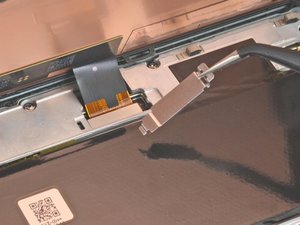By Robert Boyd • Difficulty: Moderate
This repair guide was authored by the iFixit staff and hasn’t been endorsed by Google. Learn more about our repair guides here.
Follow this guide to replace a broken or cracked screen on a Google Pixel 5.
Unlike previous Google Pixels models, the Pixel 5’s screen is reinforced with a metal frame. The earpiece speaker is also glued onto the back side of the screen.

- Heat an iOpener and apply it to the bottom edge of the screen for one minute.



- Screen seam: This seam separates the screen from the rest of the phone. Do not pry at this seam.
- Bezel seam: This is where the plastic bezel designed to protect the screen meets the frame. It's held in place by plastic clips. This is where you should pry.



- Pull the blue handle towards the hinge to disengage opening mode.
- Position the suction cups near the bottom edge of the screen—one on the front, and one on the back.
- Push down on the cups to apply suction to the desired area.



- Push the blue handle away from the hinge to engage opening mode.
- Turn the handle clockwise until you see the cups start to stretch.
- Wait one minute to give the adhesive a chance to release and present an opening gap.
- Insert an opening pick under the screen and its bezel frame when the Anti-Clamp creates a large enough gap.
- Skip the next step.



- Apply a suction cup to the screen, as close to the heated edge as possible.
- Pull up on the suction cup with strong, steady force to create a gap.
- Insert the opening pick into the gap.



- Slide the opening pick back and forth along the bottom of the screen to slice the adhesive.
- Leave the pick inserted in the bottom right corner to prevent the adhesive from re-sealing.

- Apply a heated iOpener to the left edge of the screen for one minute.



- Insert another opening pick into the bottom left corner of the screen.
- Slide the opening pick around the left corner.
- Continue to slide the pick up towards the front camera to slice the adhesive on the left edge of the screen.
- Leave the pick inserted to prevent the adhesive from re-sealing.



- Insert another opening pick into the top left corner of the screen.
- Slide the pick around the front camera and across the top edge of the phone.
- Slide the pick to the top right corner of the phone and leave the pick inserted.



- Insert an opening pick into the bottom right corner of the screen.
- Slide the pick up to the top right corner to slice the last edge of adhesive.


- Use the opening pick from the top left corner to lift up the left edge of the screen a few millimeters. This will keep the clips from snapping back down into the case.
- Lift up on the right side of the screen and open up the phone like a book.


- Use tweezers to grip the screen connector cover securing the screen flex cable.
- Push the clip in towards the connector to unlatch it.


- Remove the screen connector cover.


- Use the tip of the spudger to pry up and disconnect the screen flex cable.

- When handling your screen, grip it by its edges.
- When placing the screen on your work area, make sure nothing is touching the bottom of the screen. Consider placing it on a soft, lint-free cloth.


- Remove the screen.
Compare your new replacement part to the original part—you may need to transfer remaining components or remove adhesive backings from the new part before installing.
To reassemble your device, follow the above steps in reverse order.
Take your e-waste to an R2 or e-Stewards certified recycler.
Repair didn’t go as planned? Try some basic troubleshooting, or ask our Answers community for help.